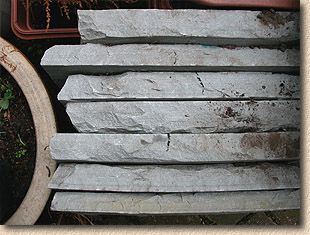I'm helping out my dad with some work laying a large area (say 12M * 10M) of indian sandstone pavers (450*450mm and some larger).
The area has foot traffic only, and he's had a decent concrete slab laid. The pavers are perfectly straight edged (I tried laying some out on flat ground and they seem very accurately cut), BUT they are not all exactly the same thickness. We live in Melbourne, Australia, with a climate something like Paris.
He's keen to butt-joint these pavers if possible, however I've heard nasting things about possible expansion from moisture cracking the pavers (if there are no joint gaps), and the laying itself being really difficult because there is no room to adjust if things get slightly out of kilter.
Only figures I could get on water absorption of indian sandstone seemed quite high (1.25% ?).
So question is: should I talk him out of butt-jointing? or should we use butt-jointing but put in expansion joints every metre or two?
One reason he is keen to butt-joint is he bought some feature slaps that are eactly double the height and width of the normal pavers, and he figures they'll fit neatly if the whole lot is butt-jointed.
Butt-jointing indian sandstone pavers?
-
Tony McC
- Site Admin
- Posts: 8346
- Joined: Mon Jul 05, 2004 7:27 pm
- Location: Warrington, People's Republic of South Lancashire
- Contact:
Butt jointing is not suitable for this type of paving because the joints, when viewed in cross-section, are not of a uniform width. Further, as explained on the main website, the falgs are not modular unless there is a wide-ish joint, usually 8-15mm, and you'll find that after laying a couple of square metres, 15-2mm wide offsets are suddenly appearing.
Butt-jointing works only with dimensionally accurate, square-sided flagstones. Any flags with fettled edges MUST be mortar jointed.
Butt-jointing works only with dimensionally accurate, square-sided flagstones. Any flags with fettled edges MUST be mortar jointed.
Site Agent - Pavingexpert
-
JoshSwinnerton
- Posts: 2
- Joined: Tue Nov 01, 2005 11:19 pm
- Location: Melbourne, Australia
Thanks Tony,
So is the only problem the difference in thickness of adjacent slabs? If so, I probably should have been more specific about the thickness difference, they only vary between the thickest and thinnest in the whole batch (3 crates) by about 10mm, and most are within 1-2mm as thick as one another. And the top-down dimensions are perfectly square.
I don't think the edges are what you call fettled, they are perfectly straight edged (from a top-down view).
So is the problem simply that the slight difference in thickness makes it impossible to get a perfectly smooth top surface?
How about expansion due to water absorption? is it true that if butt-jointed they could expand and crack due to soaking up moisture?
Thanks again for your advice - your site has the best info on this topic anywhere on the web.
So is the only problem the difference in thickness of adjacent slabs? If so, I probably should have been more specific about the thickness difference, they only vary between the thickest and thinnest in the whole batch (3 crates) by about 10mm, and most are within 1-2mm as thick as one another. And the top-down dimensions are perfectly square.
I don't think the edges are what you call fettled, they are perfectly straight edged (from a top-down view).
So is the problem simply that the slight difference in thickness makes it impossible to get a perfectly smooth top surface?
How about expansion due to water absorption? is it true that if butt-jointed they could expand and crack due to soaking up moisture?
Thanks again for your advice - your site has the best info on this topic anywhere on the web.
-
Tony McC
- Site Admin
- Posts: 8346
- Joined: Mon Jul 05, 2004 7:27 pm
- Location: Warrington, People's Republic of South Lancashire
- Contact:
I wasn't aware the flags had sawn edges. With sawn edges, you can use sand joints, so ignore everyhthing I said earlier. I assumed these were fettled edges, summat like these....

So: sand joints (2-5mm butt joints) will be fine as long as your edges are sqaure.
As for expansion due to water absorption, while this is a genuine phenomenon, you'd need a bloody big laboratory and a piece of kit capable of measuring to the nearest 1,000th of a millimetre to prove it! I can't see it being an issue on a project such as this.

So: sand joints (2-5mm butt joints) will be fine as long as your edges are sqaure.
As for expansion due to water absorption, while this is a genuine phenomenon, you'd need a bloody big laboratory and a piece of kit capable of measuring to the nearest 1,000th of a millimetre to prove it! I can't see it being an issue on a project such as this.
Site Agent - Pavingexpert